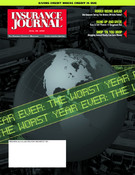The personal automobile insurance market in Texas may not be approaching the crisis level at which the homeowners market currently finds itself, but signs indicate that it may be in for a rough ride.
According to the Texas Department of Insurance (TDI) and the Independent Insurance Agents of Texas (IIAT), the personal auto market totaled more than $8 billion dollars in 2000, with carriers maintaining their hold on nearly 75 percent of that figure. By and large, leading carriers’ ranks remained as they were the previous year. Stable market share positions, however, belie trends that could eventually cause underwriters’ ink wells to dry up, and policyholders’ premiums to accelerate.
Loss ratios steadily increase
In an IIAT report on market share released in August 2001, Insurance Programs Director David Surles noted that loss ratios for the personal auto market have grown significantly every year since 1997, topping 75 percent in 2002. That marked the first time since 1995 in which the Texas loss ratio rose above the national figure.
Those loss ratios are already affecting rates at many carriers. David Wolfe, spokesman for Texas’ top auto underwriter State Farm, explained, “State Farm experienced auto policy growth in 2001 … During the same time period, we also experienced higher claims costs and expenses, as well as frequency of incidents.
“These are the primary factors which caused our private passenger auto rates in Texas to increase by an average of 9 percent this year,” Wolfe continued. “Rates for property damage, liability, collision, medical payment and uninsured motorist coverage increased the most.”
County mutuals get more mileage
Increasingly, carriers are dealing with higher loss ratios by shifting higher-risk policies to their county mutual units, which enables them to raise rates on such policies by circumventing rate regulations imposed by TDI.
Traditionally intended to underwrite high risk and non-standard coverages without being assigned to risk pools like standard carriers, county mutuals have taken on more and more standard business in the past decade. TDI’s 2001 annual report shows that when broken down from groups into individual companies, nine of the top 20 carriers are county mutuals, with Progressive, Allstate County Mutual, and State and County Mutual Fire leading the pack. Together, these units wrote more than $1.8 billion in personal auto premium in 2000—meaning more than 22 percent of the market is controlled by unregulated entities.
While county mutuals’ market share has held steady at that rate for many years, things could change. Allstate and Farmers, which together hold more than 30 percent of the personal auto market, have sent more and more business to their county mutual units. According to the IIAT, Farmers’ auto premium written through county mutuals grew to 19 percent in the second quarter of 2001 from 15 percent in the first quarter. And 30 percent of Allstate’s auto premium for the second quarter of 2001 was written by its county mutual, up from 19 percent the previous quarter.
Moreover, Allstate recently announced it intended to move about 12 percent of its auto policyholders from its standard unit, Allstate Property and Casualty, to its Allstate County Mutual unit. In a statement, Justin Schmitt, Allstate corporate relations manager, cited increasing auto losses afflicting its standard unit as the primary reason for migrating so many policyholders.
“We are now at a point where a rate increase is necessary,” Schmitt explained, “But the regulatory system in Texas has not allowed us to increase rates to the level needed to offset losses. As a result, it has become necessary to decline to renew some of our customers and instead offer them an insurance policy with an affiliated company, which has rates that are adequate to pay the claims the company expects to receive.”
Allstate intends to move approximately 264,000 of its auto policyholders to its county mutual. These policyholders have auto coverage with the company but not homeowners or other property coverage as well. Allstate identified this group as the “most inadequately priced. Not every customer in this segment has had insurance claims, but the group, on average, showed higher propensity for claims as well as higher average claim cost.”
Some 35,000 Allstate customers have already been notified about being moved to its county mutual.
State Farm has yet to take similar action, and Wolfe indicated no major migrations are planned: “We have not made any mass moves of policyholders into our county mutual affiliate.”
Mass migrations to carriers’ county mutual affiliates don’t necessarily bode ill for policyholders, however. Jerry Johns, president of Southwestern Insurance Information Service, explained, “I think you’re seeing some companies do that because we have an antiquated system of setting rates that takes into consideration data [that] is as much as two years old. It is not a true reflection of what is going on in the economic marketplace. I think when you have a government-imposed method of setting auto and homeowners rates in disregard of competition, then you see companies begin to move into a more competitive type of environment.”
Regardless of whether some carriers are using their county mutuals merely to raise rates without having to answer to TDI regulations, Johns said, “The forces of competition are going to drive from the marketplace any company that abuses the system of setting auto or homeowners rates. Consumers are extremely bright—they shop around. If a company were to be engaged in heavy prices that are significantly higher than others in the marketplace, you’re going to find that company probably with a lesser share of the market than others.”
Consumer advocacy groups such as Texas Watch and Consumers Union, however, contend that carriers are using county mutuals ultimately to increase underwriting profits. They also point out that insurers are not obligated to disclose what criteria they use to place customers in unregulated units. Some Allstate agents are already echoing that contention—one agent reports that three of her clients will face premium increases of 80 percent, even though they have never reported any claims with Allstate.
Uninsured motorists
Perhaps the biggest issue related to growing loss ratios in the Texas auto market is the number of uninsured motorists in the state. Texas insurance commissioner Jose Montemayor cited the cost of uninsured motorist coverage—up by more than 23 percent—as a primary reason for raising personal auto benchmark rates last fall. Benchmark rates rose by a statewide average of 5.3 percent, lower than what was recommended by insurers and state administrative law judges (6.9 percent and 5.8 percent, respectively), and higher than the Office of Public Insurance Counsel’s recommended 5.1 percent.
“We see 20 to 25 percent of drivers in Texas driving around without liability insurance,” Johns said. “That increases as you get closer to the border. In the Rio Grande Valley, there have been estimates at 50 to 60 percent of drivers who do not carry auto liability.”
The percentage Johns cited, however, may be too low. According to Tom Sorrels, legislative chairman of the Automobile Insurance Agents of Texas, the number of uninsured motorists is much higher: “The AIAT, in keeping with the growing number of our customers’ concerns and complaint about the number of motorists that are driving around every day without insurance … is trying to educate the Legislature and the public about the growing number of uninsured motorists, and the lack of enforcement of mandatory liability insurance.
“Until we can get the Legislature to do something, we’re going to keep doing what we’re doing, saying the numbers are wrong,” Sorrels continued. “Right now the TDI is using statistics that were put together in 1995 … The only source for that data the DPS put together was from blue forms [voluntarily filled out by motorists involved in traffic accidents] … I think people realize that the police are going to file a report to the state, so why should they [fill out the forms]?”
To obtain a more accurate idea of how many uninsured motorists there are in Texas, the AIAT has begun surveying police departments across the state. “We’ve gone to the top 50 cities in the state,” Sorrels said, “and they range anywhere from Dallas and Houston to Flower Mound, Texas. And we’re attempting to gather information that will show more precise numbers, if that’s possible.”
Once enough data is gathered to publish a final report, the AIAT will present its findings to the state legislature when it reconvenes in 2003.
“Right now the TDI and most major companies want you to believe that the growth of uninsured motorists is negligible—it’s only 22 to 23 percent,” Sorrels said. “Some companies and other associations would even say, ‘Gee, if mandatory liability isn’t working, why not do away with it?’ We can’t have that, because right now, based on police departments we’ve spoken to, courts
we’ve spoken to, the actual number of uninsured motorists is between 35 and 40 percent.”
Better access = better enforcement?
To facilitate better enforcement of auto liability insurance laws, and reduce the number of uninsured motorists in Texas, the AIAT plans to push for passage of an electronic insurance verification database enabling the police to instantly determine whether individuals involved in traffic accidents or violations have liability coverage. “What we’re proposing is an electronic database that law enforcement officials on the street have access to, and insurance companies have to notify a vendor … roughly seven to 10 days after (a policy is bought, renewed, or cancelled). In most states where databases are installed, they find out that whatever they thought their original uninsured motorist rate was, the rate doubled.”
The AIAT expects a difficult time getting such a bill passed; assuming it does, time will be needed to set up the database, and then more time will be required to determine its efficacy.
| Texas Top 20 Personal Auto Carriers 2000 | ||||
| Company Premium | ($ mil.) Market Share |
Loss Ratio
|
||
| State Farm |
1,869.1
|
22.2% | 77.0% | |
| Allstate |
1,398.8
|
16.6% | 71.1% | |
| Farmers |
1,090.7
|
13.0% | 81.1% | |
| USAA |
518.5
|
6.2% | 74.2% | |
| Progressive |
474.7
|
5.6% | 69.3% | |
| GEICO |
312.0
|
3.7% | 88.4% | |
| Nationwide |
310.3
|
3.7% | 81.1% | |
| Farm Bureau |
242.3
|
2.9% | 78.0% | |
| Home State County Mutual |
214.3
|
2.5% | 70.4% | |
| Old American |
145.6
|
1.7% | 75.0% | |
| Travelers |
137.7
|
1.6% | 75.1% | |
| Unitrin |
136.1
|
1.6% | 70.6% | |
| Titus |
125.8
|
1.5% | 73.5% | |
| SAFECO |
108.8
|
1.3% | 68.7% | |
| Hartford |
82.0
|
1.0% | 77.6% | |
| Winterthur |
81.8
|
1.0% | 57.6% | |
| Sentry |
66.5
|
0.8% | 66.3% | |
| Liberty Mutual |
66.4
|
0.8% | 67.6% | |
| CNA |
65.0
|
0.8% | 77.4% | |
| Source: Texas Department of Insurance | ||||
| Personal Auto Loss Ratios | |||
| Year | Texas Premium ($ mil.) | Texas Loss Ratio | U.S. Loss Ratio |
| 2000 |
8,413.3
|
75.5%
|
72.3%
|
| 1999 |
8,334.4
|
69.1%
|
66.3%
|
| 1998 |
8,432.4
|
62.1%
|
64.7%
|
| 1997 |
8,362.1
|
58.6%
|
63.8%
|
| 1996 |
8,016.2
|
63.6%
|
66.9%
|
| Source: Independent Insurance Agents of Texas | |||
| Top 10 Texas County Mutuals 2000 | |||
| Company | Premium ($mil.) |
Market Share
|
|
| Progressive County Mutual |
474.8
|
5.6%
|
|
| Allstate County Mutual |
302.8
|
3.6%
|
|
| State and County Mutual Fire |
272.7
|
3.2%
|
|
| Home State County Mutual |
214.3
|
2.6%
|
|
| Old American County Mutual |
145.6
|
1.7%
|
|
| Consumers County Mutual |
125.7
|
1.5%
|
|
| Farmers Texas County Mutual |
106.7
|
1.3%
|
|
| Colonial County Mutual |
102.5
|
1.2%
|
|
| Southern County Mutual |
78.4
|
0.9%
|
|
| Charter County Mutual |
63.3
|
0.8%
|
|
| Source: Texas Department of Insurance | |||
Topics Carriers Texas Agencies Auto Legislation Profit Loss Personal Auto Homeowners Law Enforcement State Farm
Was this article valuable?
Here are more articles you may enjoy.


 Florida OIR Triples the Size of Citizens’ Rate Decrease
Florida OIR Triples the Size of Citizens’ Rate Decrease  DoorDash, Uber Cost Drivers $550 Million in Tips, NYC Says
DoorDash, Uber Cost Drivers $550 Million in Tips, NYC Says  Alliant Latest to Sue Howden US Over Alleged ‘Smash-and-Grab’ Poaching
Alliant Latest to Sue Howden US Over Alleged ‘Smash-and-Grab’ Poaching  Update: Verizon Says Service Restored After Thousands Affected by Outage
Update: Verizon Says Service Restored After Thousands Affected by Outage 


